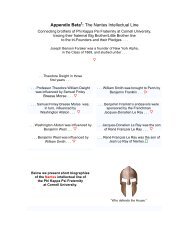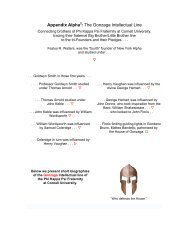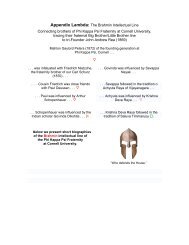Gondar - Phi Kappa Psi
Gondar - Phi Kappa Psi
Gondar - Phi Kappa Psi
Create successful ePaper yourself
Turn your PDF publications into a flip-book with our unique Google optimized e-Paper software.
In 1537 the Catholic clergy had been banished from Augsburg by the city<br />
council; but after the preaching of Canisius public processions were held,<br />
monasteries gained novices, people crowded to the jubilee indulgence,<br />
pilgrimages were revived, and frequent Communion again became the rule. After<br />
the elections of 1562 there were eighteen Protestants and twenty-seven<br />
Catholics on the city council. He received the approbation of Pius IV by a special<br />
Brief in 1561. Great services were rendered by Canisius to the Church through<br />
the extension of the Society of Jesus; the difficulties were great: lack of novices,<br />
insufficient education of some of the younger members, poverty, plague,<br />
animosity of the Protestants, jealousy on the part of fellow-Catholics, the<br />
interference of princes and city councils. Notwithstanding all this, Canisius<br />
introduced the order into Bavaria, Bohemia, Swabia, the Tyrol, and Hungary, and<br />
prepared the way in Alsace, the Palatinate, Hesse, and Poland.<br />
Even opponents admit that to the Jesuits principally is due the credit of<br />
saving a large part of Germany from religious innovation. In this work Canisius<br />
was the leader. In many respects Canisius was the product of an age which<br />
believed in strange miracles, put witches to death, and had recourse to force<br />
against the adherents of another faiih; but notwithstanding all this, Johannes<br />
Janssen does not hesitate to declare that Canisius was the most prominent and<br />
most influential Catholic reformer of the sixteenth century (Geschichte des<br />
deutschen Volkes, 15th and 16th editions, IV, p. 406). "Canisius more than any<br />
other man", writes A. Chroust, "saved for the Church of Rome the Catholic<br />
Germany of today" (Deutsche Zeitschrift für Geschichtswissenschaft, new series,<br />
II, 106). It has often been declared that Canisius in many ways resembles St.<br />
Boniface, and he is therefore called the second Apostle of Germany. The<br />
Protestant professor of theology, Paul Drews, says: "It must be admitted that,<br />
from the standpoint of Rome, he deserves the title of Apostle of Germany"<br />
("Petrus Canisius", Halle, 1892, p. 103).<br />
Soon after his death reports spread of the miraculous help obtained by<br />
invoking his name. His tomb was visited by pilgrims. The Society of Jesus<br />
decided to urge his beatification. The ecclesiastical investigations of his virtues<br />
and miracles were at first conducted by the Bishops of Fribourg, Dillingen, and<br />
Freising (1625-90); the apostolic proceedings began in 1734, but were<br />
interrupted by political and religions disorders. Gregory XVI resumed them about<br />
1833; Pius IX on 17 April, 1864, approved of four of the miracles submitted, and<br />
on 20 November, 1869, the solemn beatification took place in St. Peter's at<br />
Rome. In connection with this, there appeared between 1864-66 more than thirty<br />
different biographies. On the occasion of the tercentenarv of his death, Leo XIII<br />
issued to the bishops of Austria, Germany, and Switzerland his much-discussed<br />
"Epistola Encyclica de memoria sæculari B. Petri Canisii"; the bishops of<br />
Switzerland issued a collective pastoral; in numerous places of Europe and in<br />
some places in the United States this tercentenary was celebrated and about fifty<br />
pamphlets were published.






